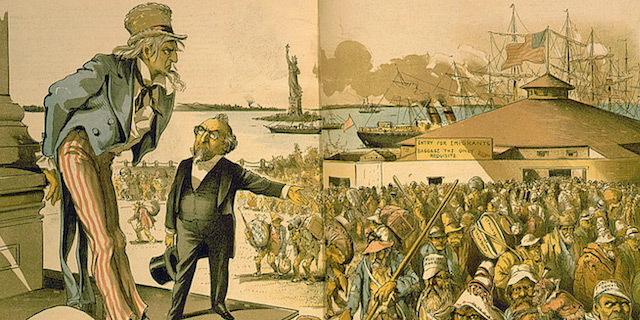An executive order and a Supreme Court ruling highlight Congress’s inaction.
 There have been points in this nation’s history where Congress took the lead on the immigration issue. The longstanding 19th- and early 20th-century boom in welcoming foreigners slowed with World War I and all but ceased with the Immigration Act of 1924, which set national-origin quotas for immigration. Four decades later, that act was reversed by the Hart-Celler Act, and in 1986 Congress liberalized immigration still further with the Simpson-Mazzoli Act. All of these were broad, sweeping pieces of legislation that radically reformed then-existing laws affecting those who wished to enter America.
There have been points in this nation’s history where Congress took the lead on the immigration issue. The longstanding 19th- and early 20th-century boom in welcoming foreigners slowed with World War I and all but ceased with the Immigration Act of 1924, which set national-origin quotas for immigration. Four decades later, that act was reversed by the Hart-Celler Act, and in 1986 Congress liberalized immigration still further with the Simpson-Mazzoli Act. All of these were broad, sweeping pieces of legislation that radically reformed then-existing laws affecting those who wished to enter America.
Since 1986, however, Congress has, with rare exceptions, punted on immigration. Now our “representatives” find it more useful as an election-time issue to demagogue the opposition while thousands attempt to find refuge in America, whether as legal visitors or “undocumented” job seekers.
In recent years, the real action on immigration has occurred in two venues: the White House and the Supreme Court. This has absolved the legislative branch of most of its responsibility, and, as an added bonus to those on the Left, has pinned down President Donald Trump from making more progress on an issue he promised to address when elected four years ago. These days, the most important month in Washington isn’t January, when new terms start, or November, when elections take place. It’s June, when the Supreme Court wraps up its annual term and announces its decisions on the most-watched cases.
Given that situation, we had immigration news on two fronts this week. From the Trump White House came an executive order extending a restriction on green cards and slicing the number of H-1B visas made available, among other things. “Under ordinary circumstances, properly administered temporary worker programs can provide benefits to the economy,” wrote President Trump in his order. “But under the extraordinary circumstances of the economic contraction resulting from the COVID-19 outbreak, certain nonimmigrant visa programs authorizing such employment pose an unusual threat to the employment of American workers.”
Reaction was predictable, with the pro-business Wall Street Journal echoing its Chamber of Commerce friends and calling Trump’s order a “gift to China” that will send jobs overseas. Meanwhile, those more hawkish on the subject, such as the editors of National Review, deemed the move “both legally sound and good policy.” Tellingly, the NR crew also remarked, “We wish Congress would not delegate its powers so extensively. But it has, and therefore it falls under the president’s purview to decide whether the pandemic has temporarily changed America’s immigration needs.”
Needless to say, both sides also count on (or dread) any excesses being adjudicated by the Supreme Court. Pro-immigrant groups got a gift last week when the Supremes twisted legal logic to uphold the Obama-era policy on so-called dreamers, but the border-security side won a victory yesterday when the Court held that asylum seekers initially denied had no right to have their cases heard in federal court. In a 7-2 ruling, the Court agreed that Vijayakumar Thuraissigiam, a Sri Lankan national, was properly denied asylum because he could not establish a credible threat of persecution. Even two leftist justices, Ruth Bader Ginsburg and Stephen Breyer, ruled with the majority, although they believed this was a distinct case and should not be used as policy. Even this one case went too far for Sonia Sotomayor and fellow Barack Obama appointee Elena Kagan. “Today’s opinion handcuffs the judiciary’s ability to perform its constitutional duty to safeguard individual liberty,” complained Sotomayor.
Also important in the case was the expansion of the venue of denial of asylum from the border itself to anywhere inside the border. In Thuraissigiam’s case, he was detained just 25 yards into the United States, but it was beyond the border and the SCOTUS ruling expanded the zone.
Ultimately, the case was in part decided based on congressional action from an era when Congress actually made laws. As Justice Samuel Alito wrote for the majority, “In 1996, when Congress enacted the Illegal Immigration Reform and Immigrant Responsibility Act … it crafted a system for weeding out patently meritless claims and expeditiously removing the aliens making such claims from the country. It was Congress’s judgment that detaining all asylum seekers until the full-blown removal process is completed would place an unacceptable burden on our immigration system and that releasing them would present an undue risk that they would fail to appear for removal proceedings.”
It may seem a foreign concept, but Congress once had its own judgment on immigration. Today, however, we’re saddled with two sides wallowing around in the mud instead of pulling together.
Written by Michael Swartz for Patriot Post ~ June 26, 2018
